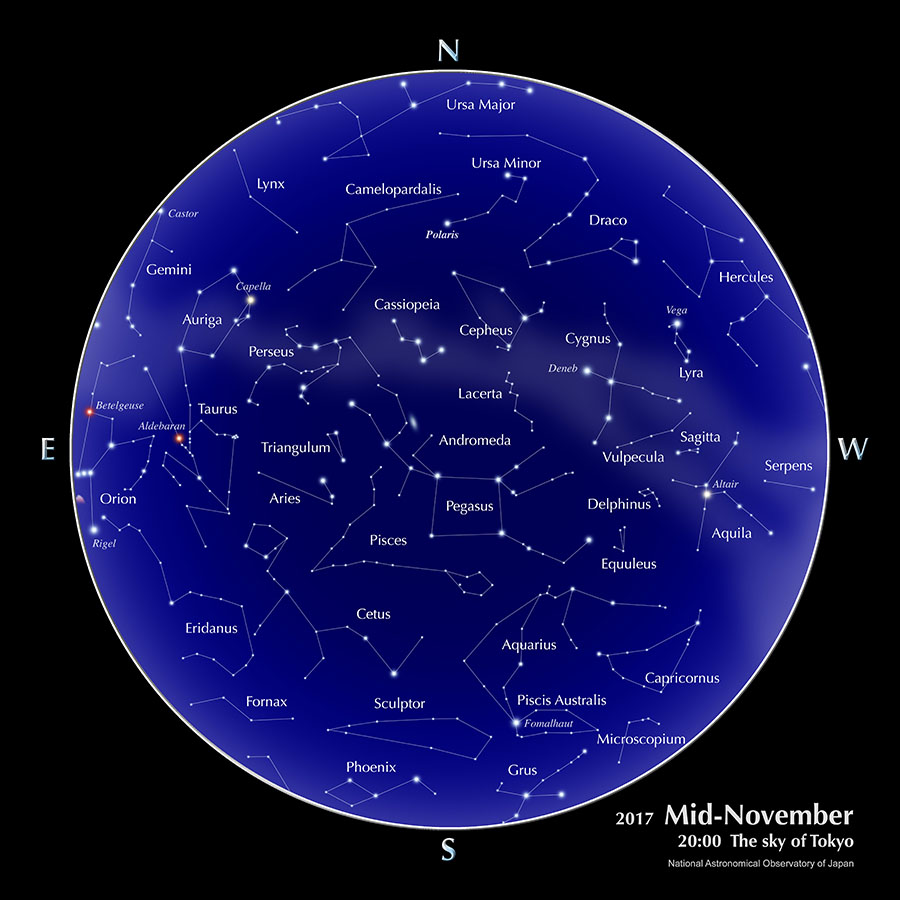The sky of Tokyo, Calendar, Planets (November, 2017)
The sky of Tokyo

Calendar (November)
| 3 | Culture Day [Bunka-no-hi](national holiday) |
| 4 | Full Moon |
| 11 | Last Quarter Moon |
| 12 | Occultation of Regulus / Northern Taurid Meteor Shower peaks around this time.(The best time to observe is before midnight in the latter part of November, when there is no effect from moonlight. On the order of 2 meteors per hour are expected.) |
| 18 | New Moon / Leonid Meteor Shower peaks around this time. (The best time for viewing is before dawn on the 18th. On the order of 2 meteors per hour are expected. Because there is no moonlight and the timing of the maximum is not so bad, conditons are relatively good.) |
| 23 | Neptune at stationary point / Labor Thanksgiving Day [Kinro-kansha-no-hi] (national holiday) |
| 24 | Greatest Eastern Elongation of Mercury |
| 27 | First Quarter Moon |
The days for the peak activities of the meteor showers are based on the predictions of IMO(International Meteor Organization).
Planets
- Mercury
- Mercury is positioned low in the southwestern sky just after sunset, but its apparent location is close to the Sun, making observation difficult. Mercury reaches its greatest eastern elongation on the 24th, but its elevation is not even 10 degrees at 30 minutes after sunset, making observation difficult.
- Venus
- Venus is positioned low in the eastern sky just before sunrise. Its brightness is -3.9 magnitude.
- Mars
- Located in the constellation Virgo, Mars can be seen in the eastern to southeastern sky before sunrise. Its brightness is 1.8 to 1.7 magnitude.
- Jupiter
- At the beginning of the month, Jupiter is located in the constellation Virgo and moves east. In the middle of the month, it moves into the constellation Libra. It is positioned low in the eastern to southeastern sky just before sunrise. At the end of the month, its elevation becomes higher, making it easier to observe. Its brightness is -1.7 magnitude.
- Saturn
- From the beginning to the middle of the month, Saturn is located in the constellation Ophiuchus and moves slowly to the east. In the last part of the month, it moves into the constellation Sagittarius. Saturn can be seen low in the southwestern to western sky after sunset. In the last part of the month, it sets at 1 hour after sunset as seen from Tokyo. Its brightness is 0.5 magnitude.
Source: Ephemeris Computation Office, NAOJ
With the “Sky Viewer” you can easily explore the appearance of a typical urban night sky (planets and constellations are visible). The Celestial Phenomena section of the glossary explains the planetary phenomena terms: greatest elongation, opposition, conjunction, stationary, etc.